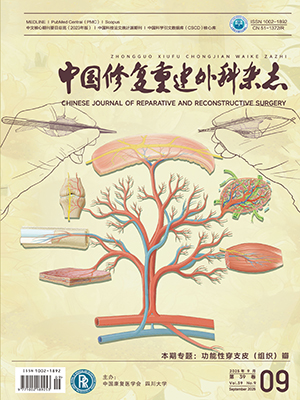Objective To investigate the result of the transplantation of frozen canine phalangeal joint allografts perforated and incorporated with autogenic bone marrow. Methods A proximal interphalangeal joint defect of 1.5 cm was prepared at bilateral sides of twenty-four adult healthy out-bred dogs. Three different types of allografts were applied to repair the defects: fresh autogenic phalangeal joints (group A,n=16), frozen phalangeal joint allografts perforated and incorporated with fresh autogenic bone marrow(group B, n=16), and frozen phalangeal joint allografts(group C, n=16). Radiographic and histological study wereused to evaluate the survival of transplanted joints. The observation was done 1, 3, 6 and 12 months after operation respectively. Results Based on the radiographic and histological changes of the transplanted joints, the osteoarthropathy of transplanted canine phalangeal joints could be divided into 3 degrees: mild degeneration, moderate degeneration and severe degeneration. Mild degeneration was observed in group A from 3 to 12 months. Mild degeneration was also found in group B from 1 to 6 months, and the endochondral ossification was obvious within the drilled bony holes.However, some joints in group B underwent moderate degeneration 12 months after operation. Group C joints in the first month had moderate degeneration, which progressed to severe egeneration 3 months after operation. Conclusion Transplantation of frozen canine phalangeal joint allografts perforated and incorporated with autogenic bone marrow can effectively delay the degeneration of transplanted osteoarticular allografts at the early and middle stage.
Citation: SHEN Zunli,JIA Wanxin,ZHANG Zhaofeng,et al.. AN EXPERIMENTAL STUDY ON TRANSPLANTATION OF FROZEN CANINE PHALANGEAL JOINT ALLOGRAFTS INCORPORATED WITH AUTOGENIC BONE MARROW. Chinese Journal of Reparative and Reconstructive Surgery, 2006, 20(1): 69-72. doi: Copy
Copyright © the editorial department of Chinese Journal of Reparative and Reconstructive Surgery of West China Medical Publisher. All rights reserved




